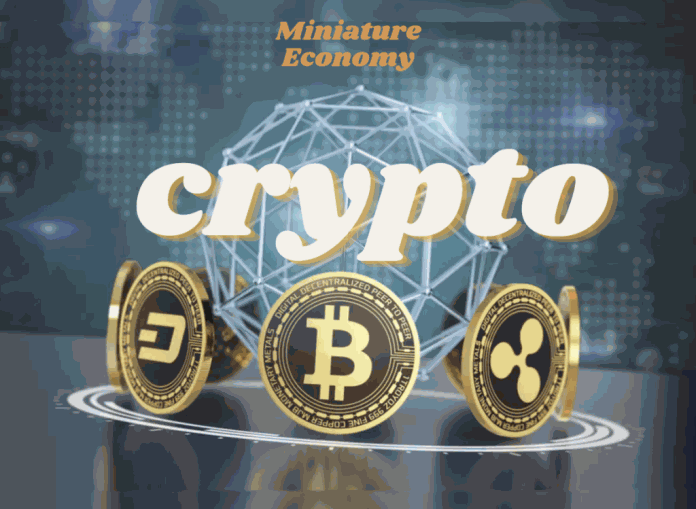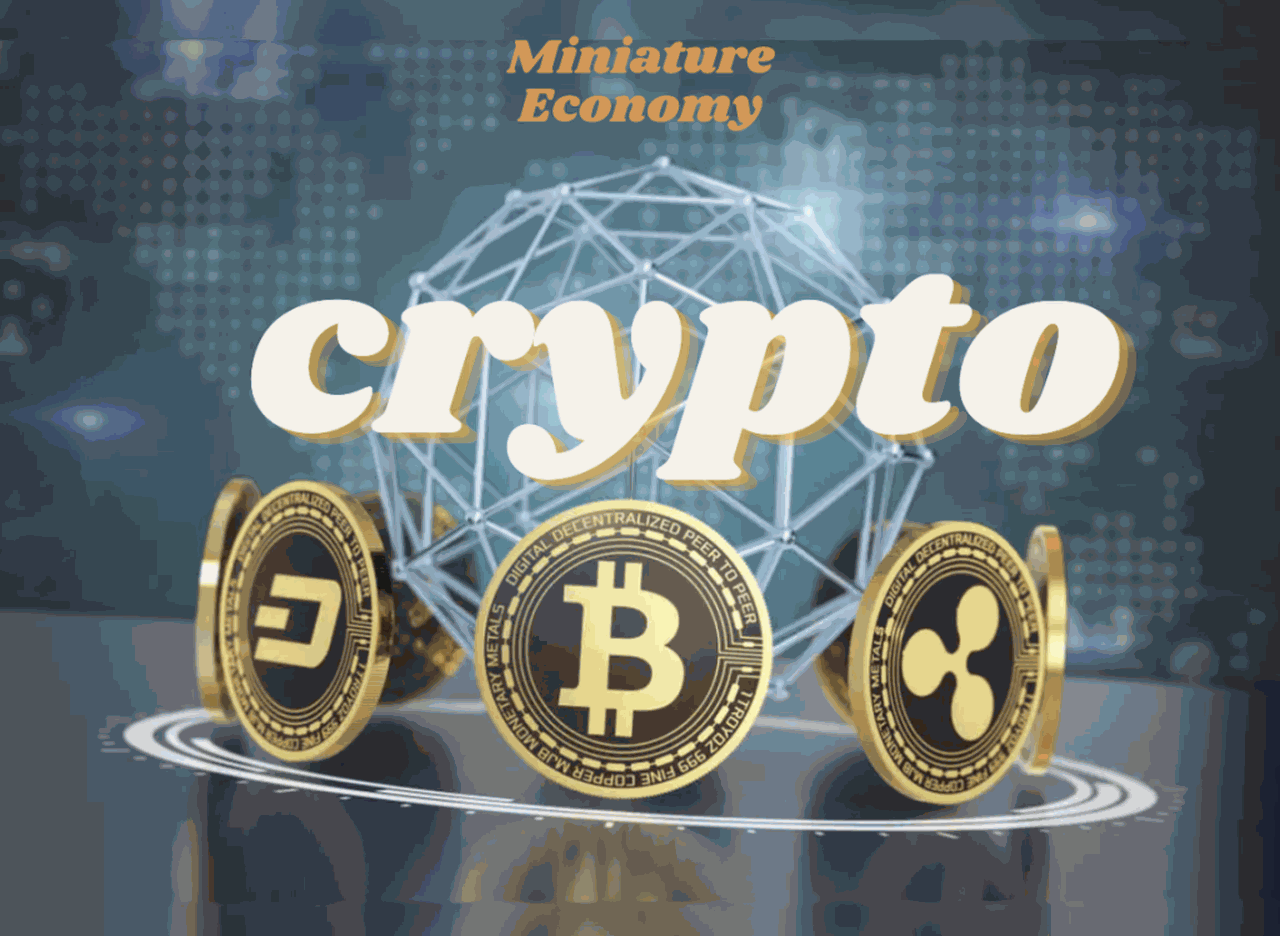
In recent years, the crypto market has emerged as a thriving and dynamic space, captivating the world with its potential to reshape traditional financial systems. In this blog post, we will confidently explore the concept of the crypto market as a miniature economy. We will delve into the key components of an economy, such as currency, supply and demand, investment, and regulation, and analyze how these elements manifest within the crypto market. By the end, you will gain a comprehensive understanding of the vibrant dynamics at play in the crypto market and its undeniable resemblance to a miniature economy.
Economy Structure and Operation of the Overview
Through a long history, there are now many theories explaining the structure and how the economy works. However, in this part, I will use General equilibrium theory (General Equilibrium Theory) was developed by French economist Leon Walras.
The structure of the economy
According to Leon Walras, in the structure of a market economy, there are three types of markets: the commodity market, the capital market, and the labor market. In there:
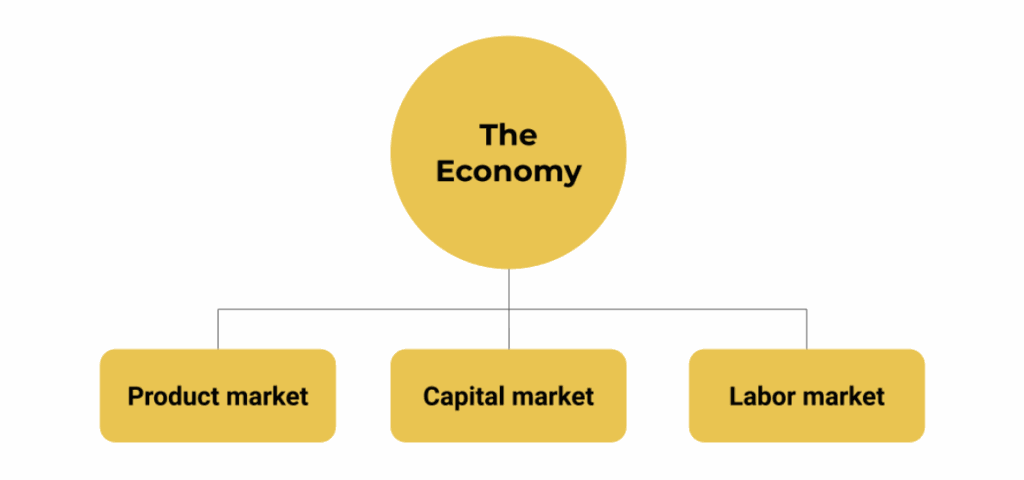
3 components of the economy
- Product Market: A place where production, supply and exchange of goods and services occur.
- Capital market: The place where borrowing and lending needs meet, forming the cost of capital and interest rates.
- Labor market: This is where labor is hired, and the price of labor (or wages) is formed.
How do these factors affect each other?
These three markets are practically independent of each other, but thanks to their production and business activities, they have a close relationship with each other.
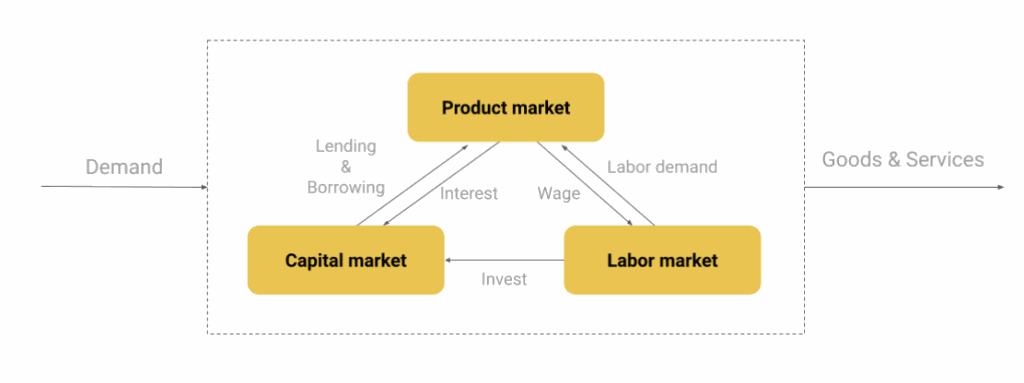
Specifically, when there is a market demand for a certain product (service or good), businesses will conduct research, manufacture and sell that product.
And during this operation, enterprises will need to borrow capital to expand production and business activities in order to earn more profits. At the same time, when the business expands, there will be more demand for hiring workers, creating the labor market.
How the economy works
The key factor of an economy is whether it creates added value or not. What is the added value here?
To simplify things for you, you can easily imagine, an economy is considered to grow when that economy creates more products (goods & services), but people must use these products. Consumption, consumption, economic growth.
=> The thing to note here is that the production of more goods and services and the demand for those products also increases. Then the economy will grow and vice versa.
.
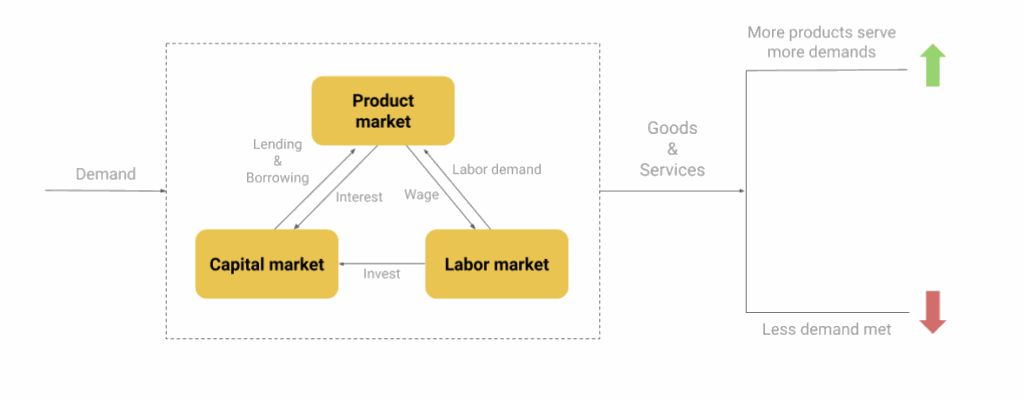
A more specific example is when the industrial revolution 4.0 occurred with the development of information technology. The economy has launched a lot of new products (eg Netflix, Facebook, Tiktok, …), and the market has received these products very positively. Thanks to that, the economy has grown, and it is said that the 4.0 revolution has great potential for the development of the economy.
And vice versa in the context of the Covid-19 epidemic. A lot of business activities are delayed due to reduced consumer demand (due to social distancing policies), resulting in goods & services produced without demand from consumers. As a result, the economy experienced a sharp decline.
Crypto & DeFi is a miniature economy
Maybe you guys will have some mindset so far: “Crypto or Bitcoin is just a financial game, just Pump & Dump”. However, if we stand on the overview from the mapping of the structure and operation of the economy above, we will have a different view of the value of Crypto & DeFi.
Where is the added value of Bitcoin?
An economy must create added value in order to survive and develop for a long time. So where is the added value of Crypto & DeFi?
Go back to Bitcoin, newly born after the 2008 economic crisis; when mentioning Bitcoin, people will think of “Payment” – A currency outside the capitalist system.
At the present time, Bitcoin is no longer tied to “Payment” but instead to “Digital Gold” or “Store of Value Asset Class”. A tool that helps us store a value that protects assets from inflation.
Recap a bit for you guys inflation problem và Store of value assets:
- As I analyzed above, the economy has growth when more goods & services are produced and the demand for the increase of those goods and services increases.
- Currency is just a tool to reflect the value of the products created and make the exchange of products easier (for example, an economy with x products will have x’ dollars in the future. printed application).
- As x increases (economic growth), x’ must increase by the same amount. However, because of the problem of asymmetric information, the government will release more money than it actually is to bootstrap the growth (like DeFi platforms create bots). Liquidity Minning Program to attract users).
- During economic downturns (corresponding to the use of the Liquidity Mining Program that the market dumps) will lead to x’ much more than x and lead to a sharp increase in inflation, causing the currency to depreciate (or the token to depreciate). as in the example). And as a result, the value of USD decreases over time, as you can see in the image below:
A famous photo of the dollar’s devaluation over time
Therefore, Bitcoin will be an asset that helps us hedge against inflation and protect our purchasing power.
It is also the added value of Bitcoin because it satisfies the need for a Store of value assets. If Bitcoin is a service, it corresponds to protecting our wealth from inflation. In addition, the increasing number of existing businesses accepting payments has further strengthened the value of Bitcoin.
Introduction to the Crypto Market
Welcome to the exciting crypto market world, where innovation and decentralization converge to create a truly transformative force. The crypto market is a thriving digital marketplace where cryptocurrencies are bought, sold, and traded. It has rapidly gained popularity, attracting millions of individuals and investors worldwide. Cryptocurrencies such as Bitcoin, Ethereum, and Litecoin are leading the charge, utilizing cryptography for security and operating independently of central banks.
Currency in the Crypto Market
Currency forms the bedrock of any economy, providing a medium of exchange and a store of value. In the crypto market, the concept of currency takes on a fascinating twist. Rather than relying on a centralized authority, cryptocurrencies operate on a decentralized blockchain, revolutionizing the notion of currency.
Cryptocurrencies serve as the primary medium of exchange within the crypto market, enabling users to purchase goods and services from forward-thinking merchants who accept digital currencies. Furthermore, cryptocurrencies can be traded against other cryptocurrencies or traditional fiat currencies on various cryptocurrency exchanges, providing a seamless and efficient method of value exchange.
Unlike traditional economies, the crypto market boasts a diverse array of currencies, each with its own unique features and purposes. This diversity reflects users’ and investors’ evolving needs and preferences, opening up a world of possibilities.
Supply and Demand in the Crypto Market
Just like in any economy, supply and demand dynamics drive the value and price of goods and services within the crypto market. The crypto market pulsates with the ebb and flow of supply and demand, shaping the prices of cryptocurrencies.
Cryptocurrencies typically have limited supplies, with many having predetermined maximum quantities. For instance, Bitcoin has a maximum supply of 21 million coins. This scarcity factor contributes to the perceived value of cryptocurrencies, often driving their prices higher.
Demand for cryptocurrencies is influenced by a multitude of factors, including investor sentiment, technological advancements, regulatory developments, and global economic conditions. Increased demand for a particular cryptocurrency can propel its price to new heights, while decreased demand can result in a temporary price decline. This interplay between supply and demand is a testament to the vibrant economic forces at work in the crypto market.
Crypto & DeFi’s Value Added
So, does Bitcoin create added value, but what about the entire Crypto and DeFi market?
Since Bitcoin creates added value, the “services” arising inside DeFi all create added value, such as:
- AMM/DEX: Make it easy for us to own a Bitcoin exchange.
- Lending & Borrowing: Where we can make more profit from lending Bitcoin and receive interest.
- Derivatives/Insurance: A tool to hedge against short-term price volatility.
- Oracles: Provides data services to ensure that there are no excessive price variances across markets.
- Asset Management: Platforms that help you achieve higher performance when holding Bitcoin (or other assets).
- …
You can refer to get an overview of the puzzle pieces in DeFi as above.
DeFi helps users capture more value from holding Bitcoin
In the process of helping you get the added value that Bitcoin creates (Store of value) or helping to optimize the profit sources, these platforms will collect a part of the fee.
With the mechanisms to capture value for the tokens of the platforms, these protocols are no different from the production enterprises whose corresponding tokens are shares on the stock market.
It’s about DeFi in particular; what about Crypto in general? As you can see, the Crypto market is not only DeFi but also has a lot of Blockchain-based Coins, NFTs, and infrastructures like Chainlink, The Graph, etc. So where is their value?
When expanding the picture above, you will see more clearly:
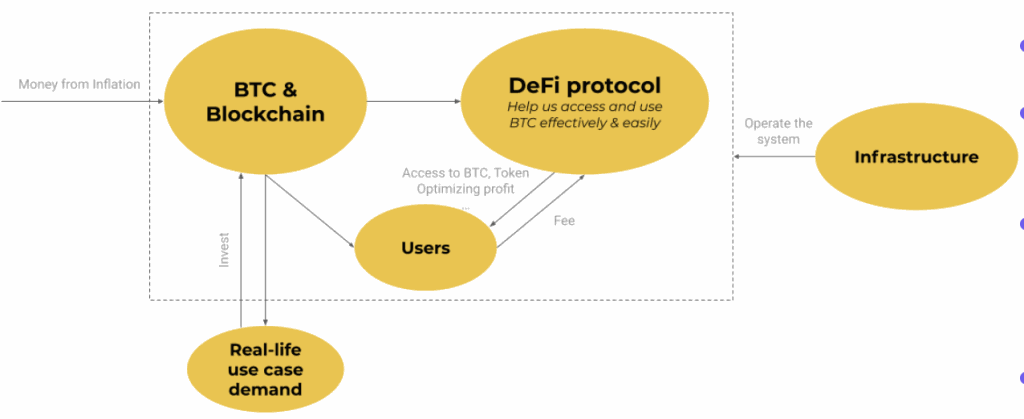
Describe simply the links in the Crypto Economy.
- Blockchains like Ethereum, BSC, Solana, etc., in addition to serving as the foundation for the development of DeFi, there are also use cases that solve many needs, such as applications in Logistics, Banking, Agriculture, Storage, etc.
- From solving problems outside of DeFi (such as entertainment, payment, …), Crypto will receive investment cash flow back and make the market grow stronger and stronger.
- Other infrastructure platforms, such as Chainlink, The Graph, etc., will be important factors for the operation of the above system.
Therefore, they both create added value on the basis of the initial formation of Bitcoin as a store of value asset.
Structure of the Crypto Market
Based on the structure of the economy consisting of 3 components, as I mentioned above, the Crypto market has the following similarities:
- Product market: As I analyzed above, the product (goods & services) in the current Crypto market is Bitcoin’s inflation hedge, DeFi services (exchange, asset management, etc.) …), collectibles and entertainment (NFT) and some Use Cases applying Blockchain in practice…
- Capital Markets: Most evident in Lending & Borrowing platforms, which work just like in traditional financial markets (just not as complicated).
- Labor market: Crypto employees (or developers) are still mostly employed in the traditional economy. As for the trustless and decentralized labor market platforms, I currently see very little. There are only a few outstanding examples currently.
Since the origin of the Crypto market originates and is built on Bitcoin – a financial asset, you can clearly see that the products built on it have a very financial bias.
The proof lies in the underdeveloped labor market (decentralized or built on a blockchain) and the product market mainly related to finance (current NFT collectibles and entertainment applications). still quite heavy on finance and investment).
Thus, the current Crypto economy still lacks many pieces, and the markets are not diversified. Therefore, the opportunity for Crypto to develop beyond DeFi today is huge.
Development trend of Crypto Economy (cEconomy)
In this section, I will compare and analyze the economy’s historical development and, based on that, forecast the future of the “Crypto Economy”.
Development history
History of formation and development of the economy (in a simple way):
- The starting economy is mainly based on subsistence farming; the products produced are also very simple (agriculture and livestock are the main ones).
- The industrial revolution period diminished the role of subsistence farming, shifting it to more extensive and monocultural forms of agriculture over the past three centuries. Economic growth mainly occurred in the mining, construction and manufacturing industries. Trade became more important due to the community’s improved need for product exchange and distribution.
- In the economies of the modern consumer society, more and more services, finance and technology are contributing…
Comparing the Crypto market, we can see a similarity:

Contrast with the development of the Crypto market.
- Start with the development of Bitcoin (which is the most basic commodity).
- The advent of Ethereum and Smart contracts is like the industrial revolution, opening many applications for Crypto as the infrastructure to develop the next phases (like industrial development, building bridges and roads to serve the next step). subsequent development). DeFi in this phase of development.
- Cross-chain, Multi-chain and interoperability between chains are developed (similar to international trade); value flows are passed between chains to optimize each other’s strengths. As DeFi Dapps develop on gradually saturated ecosystems, multi-chain interaction will be needed to maximize benefits.
- More and more Dapps in many fields other than DeFi are gradually being built.
Future trends
Compared with the development of the economy, you will clearly see the fact that the economy is developed from simple to complex and with many different relationships.
And in the process of economic development, the old occupations are not lost but, on the contrary, still have growth (agriculture & livestock are still growing) but will develop into a different complex form. more complicated.
The Crypto market, in general, is still quite small at the moment and has a lot of potential for development in the future. But what about going about each part of the economy? In what direction will they develop?
In terms of development history:
- As you can see, in the current market, BTC, along with other Blockchains, has developed a lot and is gradually becoming more saturated. In the long term, they will continue to grow but will have a slower growth rate than the following Sectors.
- With Smart contracts and the DeFi market, I still see that the puzzle pieces are still quite young at the moment DeFi Stacks are not fully Filled (we can see that AMM, Lending, Stablecoin, … are very developed, but other pieces like Derivatives or Asset Management, etc. have not made much mark on the market).
- This was followed by the development of Multi-chain and Cross-chain (like international trade in the economy). Although this has happened quite often throughout the history of development, certain infrastructures (such as the development of seaports and transportation systems in traditional markets) are needed to promote this segment. Be strong.
- And then there are other Dapps developed to serve more purposes in life outside of DeFi. In this case, we can mention some typical examples, such as the Gaming segment with Trend Play to Earn, the MUSIC segment with AUDIO, the art collection segment with NFT launching & Marketplace platforms,…
Considering the structure of the economy:
- Product market: Currently, the main products are still heavily financial. Therefore in the future, the trend will continue to develop existing products (DeFi & Blockchain), and at the same time, we will see many new trends, such as Gaming or NFT (Products that go outside the financial sector). ).
- Capital Market: Since the Crypto market is growing, with DeFi currently being the strongest, it seems that the capital market in Crypto is slowly approaching saturation. However, niches can still develop in this market (I will have a more detailed analysis of this segment in this series).
- Labor market: This is a fairly new niche in the Crypto market, as currently, only the most prominent appearance is Keep3r Network and Human Protocol. So this can also be a place where we find good investment opportunities.
Thus, with the increasing popularity of Blockchain, many products will be built in the future, and there are always many opportunities in the market.
Conclusion
In conclusion, the crypto market stands tall as a vibrant and thriving miniature economy, confidently reshaping traditional financial systems. With its own currency, supply and demand dynamics, investment opportunities, and evolving regulatory landscape, the crypto market bears striking resemblances to traditional economies. While it may have unique features and challenges, its undeniable impact and influence continue to reshape the global financial landscape.
As the crypto market continues to mature, we can confidently anticipate its further integration with the traditional economy. The potential for increased collaboration and innovation between these two worlds is immense, promising a future where the boundaries between traditional finance and the crypto market blur. Embrace the crypto market’s confident ascent and prepare to ride the wave of this miniature economy’s extraordinary potential.


